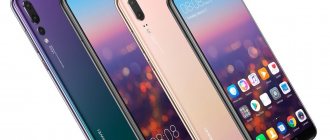Design
Honor 8X looks luxurious.
I'm talking specifically about the red color that came into my hands. There are also blue and black ones - they are less spectacular, but also good.
But probably no other can compare with the rich ruby color of the case: it is bright, juicy, deep. The iridescent glossy back of the smartphone looks so elegant and impressive that you just can’t take your eyes off it for the first few days. Yes, perhaps this color is more suitable for the female half - but this does not make the smartphone any less beautiful. I would go with him myself. Honestly.
There is a special strip made for the two rear cameras and the logo, which are located on the left side of the body: we saw something similar on the old Lenovo Vibe Shot camera phone. But if there the stripe was matte (and metallic), then here it is also glossy, only in different shades from the main color.
There is a small flaw in the case - it gets very dirty.
There are plenty of fingerprints on the back, from almost any touch. Dust also sticks to it. And this is sad, because such beauty is quickly spoiled by all sorts of external manifestations. And I really don’t want to cover it with a cover.
We also keep in mind that the smartphone is quite slippery.
Moreover, this is unnoticeable when it is in your hands, but plays a big role when the device is lying somewhere. A tiny slope of the surface - that's all, the phone slowly moved along it. So the risk of falling increases if you place it poorly.
Let's move on to the front side, which also looks very cool.
Yes, there is a visor, but it was made minimally wide, so it is not very noticeable. There are frames around the screen, traditionally for Honor and Huawei, although they are not wide. The good news here is that the lower chin is not much wider than the other strips around the screen (the thickness is only 4.25 mm). It is so thanks to COF technology, which allows the charging socket to be placed not in the body itself, but under the screen - hence the compactness. I don’t rule out that the chin can still be called wide - but we’ve seen much wider and worse ones: in the same Huawei Nova 3 or Xiaomi Mi A2 Lite.
Therefore, everything looks neat and consistent, not a single element spoils the overall impression. Although, of course, I would like to see the frames on all sides narrower - then it would be generally ideal.
Honor 8X: Performance Test
As I already said, Honor 8X is one of the most popular smartphones from the Honor brand. The Chinese manufacturer had sold about 10 million units at the end of February 2021. The smartphone was launched in September 2021, but it is still selling well in May 2021.
Let's start the performance test with the AnTuTu benchmark. As you can see, Honor 8X scores almost 140,000 points.
The next test is called GeekBench 4. In the single-core test, the smartphone scored 1615, and in the multi-core test - 5662.
The last one is 3D Mark. As you can see, Honor 8X has an overall score of 1452.
I also tested Wi-Fi speed, memory speed and GPS. By the way, I have the Chinese version of Honor 8X, and my smartphone does not have NFC, unlike the global version.
Display
I already talked about the frames and bangs, now let’s turn our attention directly to the screen itself.
The 6.5-inch matrix with FHD+ resolution offers high-quality and clear images. We won't find any pixels or other problems here.
There is, however, the opportunity to lower the resolution to HD+ to save battery power - in this resolution, of course, the quality deteriorates. The phone can do this itself using the “smart screen” mode.
I also really liked the Honor 8X display for its colors and saturation. You know, sometimes it happens that the colors are rich and bright, but slightly “hit” the eyes. Here this negative point is not present, and the color temperature is still bright and cool. But whoever doesn’t like it, you can traditionally adjust it in the settings.
The display itself is very bright, so it will be more than enough in the sun. But there is also a fly in the ointment.
Sometimes there are problems with auto brightness.
I already encountered the same problem with Huawei Mate 20 Lite. The brightness is not always reduced to the desired level in dark rooms, and can blind the owner of the smartphone. In such cases, if Honor does not get used to it over time, you will have to turn the slider manually.
Otherwise, the device’s display left only positive impressions. And not only because of the quality of the picture, but also because of the small, unobtrusive visor - thanks to it, a lot of useful information can be placed on the sides. So everything is not only beautiful, but also practical.
⇡#Shooting quality
The Honor 8X, like any other smartphone in the same price category, does not pretend to be a camera phone, although the presence of two lenses on the rear panel may mislead the inexperienced user. So, you don’t have much hope for the second matrix: its resolution is only 2 megapixels, and it is needed, in fact, only for better separation of the foreground from the background and subsequent software blurring of the background. Well, all the main work falls on the second module with a resolution of 20 megapixels and an aperture ratio of ƒ/1.8.
By class standards, the device takes photographs quite well. There are no problems at all in obtaining good, detailed images during the day, including in dull cloudy weather.
The device does not give up even if you need to take a macro photograph of some flower or other relatively small object: everything is in order with sharpness at the focus point, and there is a beautiful blur around it. You can bring the lens quite close to the subject.
The dynamic range is not particularly wide, but the automation tries its best to “pull out” overexposed or underexposed fragments of frames. In the second case, however, the situation results in a drop in sharpness in dark areas and the appearance of noise.
If, when shooting outdoors, the camera forgives the format of working in the “point and shoot” mode, then this will no longer work indoors. There is no stabilizer, so you need to hold the smartphone firmly and levelly in your hands, and be sure to remember to select the desired focus point. If you also slightly manually adjust the exposure using the slider, then the amount of noise will be minimal, and the sharpness will drop slightly compared to daytime photos outdoors.
Well, taking photographs at night with a phone, of course, becomes quite difficult. Sharpness drops significantly, a lot of noise appears, and attempts by the built-in noise reduction to smooth them out sometimes make the frames frankly plastic. And the Honor 8X struggles with complex mixed artificial light. However, this is all completely normal and expected for a smartphone for this kind of money.
The front camera with a resolution of 16 megapixels is very decent. In the dark, of course, you shouldn’t expect cool self-portraits from her, but in daylight and with sufficient artificial light, selfies are only pleasing: the color rendition is normal, and the detailing is absolutely wonderful. The main thing, again, is not to rush anywhere and do not forget to choose a focus point, since there is autofocus here.
There's not much to say about video shooting. Yes, you can record videos in Full HD resolution at 30 frames/s, but this is all more of a “capture the moment” kind of thing. During the day the quality is decent, in all other cases it’s so-so.
Specifications Honor 8X (JSN-L21)
- 6.5-inch display with a resolution of 2340 x 1080 pixels (FHD+, 19.5:9, 397 ppi)
- Huawei Kirin 710 processor (4 cores Cortex-A73 2.2 GHz + 4 cores Cortex-A53 1.7 GHz)
- Mali-G51 graphics
- RAM 4 GB
- storage 64/128 GB
- support Micro SD cards up to 256 GB
- two rear cameras 20 + 2 MP (f/1.8, video recording 1080p 60 fps)
- front camera 16 MP (f/2.0, video 1080p 30 fps)
- battery 3750 mAh
- OS Android 8.1 Oreo + EMUI 8.2 shell
- sensors: accelerometer, compass, gyroscope, light sensor, distance sensor, fingerprint scanner
- Connectors: Micro USB (OTG works), 3.5 mm headphone jack
- Dimensions: 160.4 x 76.6 x 7.8 mm, weight 175 g
Wireless interfaces:
- 2G, 3G, 4G LTE (bands: 1 / 3 / 7 / 8 / 20)
- two Nano SIM cards
- Wi-Fi 802.11 (a/b/g/n/ac, 2.4 GHz/5 GHz), Bluetooth 4.2, NFC
- GPS, GLONASS, BeiDou
What's good about this? First of all, the presence of NFC is cool that another average person has received a contactless payment module. And also the presence of an audio output for headphones, which, fortunately, was not removed from the Honor 8X. And they installed a separate tray, for two SIM cards and SD at once. Beauty! The only thing that’s a little disappointing is Micro USB instead of the modern and cool USB Type-C.
As for unlocking methods, there are two of them.
And they work without any complaints at all.
The fingerprint scanner, located on the back of the case, works quickly and stably: the finger is always read, the screen is activated almost instantly (maximum 1 second).
With face unlocking, everything is also fine: reading again takes no more than a second, and no jambs were noticed with it. True, the process itself is not very convenient: first I pressed the power button, then the face was counted, and then I swiped to unlock the screen. But the first action can be eliminated if you activate the function of turning on the screen when you pick up the smartphone.
⇡#Design and ergonomics
Honor 8X is a representative of the class of mid-price smartphones, with a bias towards the budget side: the device costs less than 20,000 rubles. And it is beyond this point that manufacturers usually begin to cut corners, and first of all, all designer delights go under the knife. Surprisingly, the hero of today’s review successfully passed this sad fate. The smartphone looks very attractive, not inferior in appearance to the 2-3 times more expensive Huawei P20 and P20 Pro.
Actually, the design concept here is exactly the same. The base of the gadget is metal, on the back there is glass with a texture underneath that shimmers beautifully in the light, and on the front there is a rather compact “unibrow”. There are no physical buttons on the front panel; the display occupies maximum of its area. Almost 85%, by the way, which is quite good for this price category.
Honor 8X, left side: power and volume buttons
This is the corporate style of Huawei and its sub-brand Honor. You can approach it in different ways: I know people who are not delighted with all this, but personally I like it: positive, bright, but not too pretentious. There are three color options - red, blue, and black for lovers of strict classics. The second option, for my personal taste, is optimal.
After my personal Samsung Galaxy S8+, I didn’t have to get used to the ergonomics of the Honor 8X at all – the sizes of the cases are almost the same. But objectively, a gadget with a 6.5-inch screen diagonal is, of course, a shovel. If before this you had any 5.5- or 5.2-inch smartphone, then new experiences are guaranteed.
However, you shouldn’t be afraid of them - you’ll get used to it quickly. Moreover, the matte frame does not slip in the hand, the glass of the rear panel also does not slip out of the palm, and the developers conveniently placed the volume and power buttons on the right side, exactly in the place where the thumb rests. If you hold the device with your left hand, then your index and middle fingers touch these buttons. In theory, lefties can also be comfortable, but I’m not an expert in this regard.
Honor 8X, right side: sliding tray for SIM cards and memory cards
The glass on the back panel, of course, is very quickly covered with fingerprints, although on the Honor 8X in red this is not particularly noticeable. By the way, glass is quite easy to scratch, so it is better to handle the gadget carefully. The fingerprint scanner works quickly and accurately - during the entire testing period there were no questions about it.
The only thing that seems dubious is the solution with two camera lenses protruding very noticeably beyond the body. They always cling to your jeans pocket or scratch on the table when you put your smartphone on it without a case. Well, they collect all sorts of dust particles and other small debris.
Honor 8X, top edge: microphone
Honor 8X, bottom edge: speaker grille, microphone, microUSB, headphone jack
Display , sound and software _
As mentioned a little earlier, the Honor 8X display diagonal is 6.5 inches. It is built on the basis of a widescreen IPS matrix with a resolution of 2340 × 1080 pixels. The extra 420 pixels in height come from the on-screen buttons and the notch border at the top of the screen. The aspect ratio is 19.5:9, and the pixel density reaches almost 400 pixels per inch.
From a subjective point of view, this is a very high-quality screen. It has an average brightness reserve (427 cd/m2), but if you turn it up to maximum, the device is absolutely comfortable to use outdoors. The minimum brightness level is also worthy of special praise – it’s comfortable to read e-books in the dark at night. The viewing angles are excellent, color rendition is fine by eye, detail is excellent, there are no hints of grain. The contrast is at an average level for a mobile IPS display – 1056:1.
Keep in mind that the Honor 8X display comes with a protective film attached at the factory. There is an oleophobic coating on it, but its quality is... a B with a big minus. Plus, the material from which the film is made is not very durable - already on the second day of testing, out of nowhere, a deep, long scratch appeared on it exactly under the “unibrow”. Of course, it's better than nothing, but just keep in mind that it's unlikely to last long. Huawei didn’t skimp on the oleophobic coating of the screen itself this time (there have been precedents before) - it’s there, it’s normal, and that’s good news.
Honor 8X, bright mode, gamma. Yellow line – Honor 8X performance, dotted line – reference range
Honor 8X, bright mode, color temperature. Blue line – Honor 8X performance, dotted line – reference temperature
Honor 8X, bright mode, color gamut. Gray triangle – sRGB coverage, white triangle – Honor 8X coverage
There are two color rendering presets in the Honor 8X, as in all Huawei smartphones of the current year – “bright” and “normal”. By default, the smartphone operates in bright mode, which implies a color space slightly wider than sRGB, a gamma of around 2.17 and an increased color temperature (8,000 K on average with peaks up to 9,000 K). The average DeltaE deviation for the extended Color Checker palette (shades of gray + a wide range of color shades) is 6.50 (with a norm of 3.00). This mode actually achieves higher brightness and makes colors appear richer and cooler than they actually are.
Honor 8X, normal mode, gamma. Yellow line – Honor 8X performance, dotted line – reference range
Honor 8X, normal mode, color temperature. Blue line – Honor 8X performance, dotted line – reference temperature
Honor 8X, normal mode, color gamut. Gray triangle – sRGB coverage, white triangle – Honor 8X coverage
But if you change the mode to normal, the colors will approach the norm: the gamma is 2.27, the temperature tends to 6500 K, and the curve almost does not jump, and the average deviation DeltaE on the Color Checker scale is 2.90, which already fits within the normal limits . It should be admitted that the Honor 8X display is configured very well - by smartphone standards.
Honor 8X runs Android 8.1 operating system with EMUI 8.2. The Huawei branded shell, like the design of a smartphone, can also be treated differently. But it has one unconditional advantage: the presence of quite a large number of additional settings in the menu. There is quite flexible color adjustment, the ability to hide bangs, switching between HD+ and Full HD+, a convenient phone manager, and the ability to select sound presets for various headphones.
Gallery of skinshots
View all images (15)The Honor 8X itself, however, does not at all pretend to be a phone for lovers of high-quality audio. Yes, there is a headphone jack and aptX support, but without aptX HD. And even the Bluetooth version is only 4.2, not 5.0. Well, there’s no talk about a separate audio chip. However, is it fair to blame a smartphone that costs less than 20,000 rubles for lacking all this? In our opinion, no.
But there is face unlocking of the smartphone. Without any fancy sensors or infrared illumination, of course, just the front camera. It works quickly and quite accurately, but the latter is only true if there is enough light. The darker it is around, the more difficult it is for the front camera to recognize the user’s face. In general, it’s convenient, but there are quite a few questions about the safety of this approach.
Hardware , performance and wireless communications
Inside the Honor 8X, Huawei’s proprietary chipset is installed – HiSilicon Kirin 710. It is eight-core: four Cortex A73 cores with a maximum frequency of 2.2 GHz, plus the same number of Cortex A53 cores with a frequency of 1.7 GHz. Mali-G51 MP4 graphics with a frequency of 650 MHz are also integrated here. Based on the specifications, it is not difficult to guess that this chip is a direct competitor to the Snapdragon 636 from Qualcomm. In the second case, the graphics subsystem is a little better, but the GPU Turbo algorithm - also a Huawei proprietary feature - brings the graphics to a level where we can at least talk about fair parity.
There are no complaints about the performance of the system and the behavior of the smartphone while surfing the web, watching videos, working with documents, mail or communicating in instant messengers. The available 4 GB of RAM is absolutely enough for normal multitasking.
In games, the device also does not lose face: absolutely all top mobile projects can be played at least on medium graphics settings. At the same time, the phone does not heat up like an iron, but only becomes slightly warm. There is certainly throttling: in the corresponding test, 15 minutes after it started, performance dropped by 19% from the stated maximum. The loss is noticeable, but not so critical - we've seen worse.
There is a lot of built-in memory: 128 GB inside the smartphone for less than 20,000 rubles - that’s really cool. By the way, not even all flagships can boast of this. Well, even 64 GB in the younger version of the Honor 8X for 18 thousand looks great. And this despite the fact that the developers did not skimp on a separate slot for a microSD card. So you can enjoy all the joys of life with two SIMs, and expand the memory if you ever need it.
The connection quality is fine: LTE, although only Cat. 4, but in real life it is unlikely that you will be able to reach the maximum declared data transfer speed limit of 150 Mbit/s. Wi-Fi picks up signals in both bands and transmits and receives data very quickly. And NFC (in PCT versions of Honor 8X) is available, which in this price category becomes a significant advantage compared to other competitors from China.
Performance
The role of the chip here is played by the brand new Kirin 710, a mid-level processor. In combination with 4 GB of RAM (of which 2.5 GB is free), the result is excellent performance: everything is smooth, playful, without freezes or glitches. Applications launch quickly, and the device handles multitasking well.
But I cannot confirm good performance with numbers from synthetic tests. Again. If anyone has read our reviews of Huawei Nova 3 or Mate 20 Lite, you will have seen that there were big problems with the benchmarks due to the firmware of the devices.
And Honor has this problem - benchmarks are not installed in any way.
So the problem, which was already pretty boring to me, has moved from Huawei to Honor smartphones. This, of course, will not affect the users of the device in any bad way - it’s just that none of us will know how many points our today’s hero gets in AnTuTu or Geekbench. For the time being.
Now let's see how the 8X performs in heavy toys.
PUBG
World Of Tanks
PUBG Mobile runs only on medium graphics settings, but it does so quickly and with virtually no problems. Sometimes there are sudden jerks in the picture, but there are no serious freezes or lags. In half an hour of active play (statistics for some reason show a full hour of use), the device consumed 9% of its charge - a good indicator.
In World Of Tanks it is also better to play on medium settings, everything runs smoothly there and there is nothing to complain about at all. At high settings it is also possible, but after a while the brakes and freezes begin. In half an hour of battles in “tanks,” the smartphone lost only 7% of its battery charge.
⇡#Camera
Honor 10X Lite received a block of four cameras, but, as is most often the case in the near-budget segment, you should not count on many available focal lengths in this regard. Two of the four cameras are responsible for different viewing angles, and two more are responsible for macro photography and assistance with software background blur.
The main camera has a 48-megapixel Quad Bayer sensor (physical dimensions - 1/2.0 inch) with an ƒ/1.8 aperture lens, phase detection autofocus and an equivalent focal length of 28 mm. The second camera is responsible for an expanded viewing angle - it is an 8-megapixel module with an ƒ/2.4 aperture lens, giving a coverage angle of 120 degrees. It lacks autofocus. This is the same pair that we saw on both last year's Honor 9X and the recent Honor 30i.
| On the left are pictures taken with the main camera, on the right – with the wide-angle camera | ||
The main camera gives you some freedom when choosing lighting for shooting, producing a high-quality image (both in terms of detail and dynamic range) both outdoors on a cloudy day, in sunny weather, indoors, and even at night with street lighting. In the dark, the quality of shooting naturally drops, but it is still possible to take a sharp shot. I note both good color rendition and well-set white balance. But the wide-angle module no longer shines with image quality - you can get decent shots only during the day or indoors in bright light. Moreover, even in this case there will be a very noticeable drop in sharpness at the edges (with generally mediocre detail) and the white balance will not be changed for the better compared to what was obtained on the main module.
Zoom is only available digitally – up to six times. Despite the presence of a camera with a Quad Bayer sensor, which allows for “tricky” cropping, the loss in quality is already noticeable at a two-fold zoom, not to mention a six-fold one. You can get a discernible image, but you can’t talk about quality.
| On the left is a photo in standard mode, on the right is in night mode | ||
In the dark, it’s no longer possible to get a high-quality picture with a wide-angle camera - it’s simply impossible to shoot without serious blur, the percentage of defects is too high. And when it does work out, the sharply decreasing detail attracts attention - the noise reduction is very active. The proprietary night mode, which combines several images into one with increased clarity and expanded dynamic range, is available only for a standard viewing angle - and it works well: yes, contour sharpness is noticeably improved, but it cannot be said that this is definitely detrimental to the images. Sometimes, however, in an attempt to increase the brightness of a sky that is too dark, a smartphone can add quite a lot of noise.
| On the left is a photo in standard resolution (12 megapixels), on the right - in maximum resolution (48 megapixels) | ||
The Honor 10X Lite camera can shoot with both the default resolution of 12 megapixels and 48 megapixels - this mode is manually selected.
There is also - using machine learning technologies, the smartphone recognizes many scenes and adapts the picture taking into account this knowledge. As a rule, the same operations are performed - contrast and saturation are raised. This usually has a rather good effect on the result.
The third camera is responsible for macro photography. Due to the two-megapixel sensor, the pictures are of low resolution and weigh only half a megabyte, but in principle it is possible to take an interesting close-up for posting on social networks, the main thing is to do it in good lighting: the optics are not fast (ƒ/2.4), yes and the sensor is tiny.
The fourth camera is a depth sensor used in portrait mode, in which a single focal length is available, which encourages shooting full-length or half-length portraits: in them, spatial distortions are not noticeable. Close-ups come out so-so with this camera, although in our age of winning selfies, such stretched faces will no longer surprise anyone. The Honor 10X Lite “washes the background” normally, although it cannot do without artifacts, and it still cannot draw truly spectacular bokeh in the manner of flagships or conventional mid-range camera phones (like vivo V20).
The camera application is typical for smartphones with EMUI: horizontal navigation, a set of familiar settings. A “professional” mode with manual settings is available, but without the ability to shoot in RAW.
Gallery of pictures
View all images (19)In video shooting, the Honor 10X Lite's capabilities are limited to Full HD resolution at up to 60 frames per second. There is no stabilization. In terms of video, inexpensive Honors are for some reason massively inferior to their competitors.
The front camera has an 8-megapixel sensor and ƒ/2.0 aperture optics. There is no autofocus or flash. The shooting quality is average (the dynamic range is weak, the camera is lukewarm in terms of color rendering, the angle is too wide), but there is a portrait mode and a beauty feature.
Software
Here I would like to touch on one aspect of the EMUI shell - it allows you to replace the usual touch control buttons with one single key. Essentially, it's similar to the control from the iPhone. It is quite convenient to use, but at first it is unusual.
Everything works using presses of different duration levels, as well as swiping left/right on the button itself (to open the recent applications screen, for example). All possibilities are shown in the screenshots above.
Honor 8X: Camera app
Now let's talk about the camera app. I like Huawei and Honor smartphones because they have many different shooting modes such as Aperture, Night, Portrait, Photo, Video. In addition, you can click on - More - and see other useful modes: Pro, Slow Motion, Panorama, AR Lens and others.
One of the main features of the Honor 8X smartphone camera is artificial intelligence. The AI algorithm recognizes up to 22 scenes and automatically adjusts various parameters such as contrast, brightness, etc.
The photo settings menu has standard parameters: resolution, GPS tag, watermark and more.
The video settings menu allows you to select the video format and resolution. Maximum resolution is Full HD at 60 frames per second. Unfortunately, there is no option for image stabilization in the settings menu.
Video recording
Regular video is recorded in a maximum of FHD 1080p (60 fps). If anyone wanted to make videos in 4K, this is not the place. But Honor 8X is still in the middle segment, so it’s not surprising. The video comes out clear and detailed, but when viewed from a computer, there is a slight loss of quality. The main problem is the lack of a stabilizer for maximum resolution, so the picture shakes quite a bit.
The slow motion mode here is absolutely the same as in the Huawei Mate 20 Lite. The same two slow motion modes are available: 120 fps and 480 fps at HD 720p resolution.
At the same time, the best image quality awaits us at 120 fps, but the mode has its own standard disadvantage:
Presence of sound during recording.
The sound, of course, slows down along with the picture. And it’s better not to listen to what comes out as a result - you’ll just find a slow-motion cacaphony of noise and rattling.
Slo-mo 480 fps offers a slightly worse picture quality, but there is more slowdown, and there is no sound. It turns out that both modes have their shortcomings and neither one can be called more favorable for shooting.
Honor 8X: Unboxing
The Honor 8X smartphone comes in a blue cardboard box. There's a large 8X logo on the front, and a list of technical specifications on one side.
Opening the box, you will find a smartphone in the original film, a microUSB cable, a power adapter, a silicone protective case and a user manual.
I have the Chinese version of Honor 8X. As far as I know, the global version of the smartphone has a different box design and headphones included.
Sound
I really enjoyed listening to music on headphones with the Honor 8X. The sound is clear, without unnecessary noise or wheezing, the lows and highs are perfectly audible. Yes, the sound is not exactly ideal, but you get pleasure from listening to the tracks, and this is the most important thing. In addition, the native player offers many effects for improving and changing the sound - they are shown in the screenshots below.
But the external speaker is frankly weak.
The sound is somewhat noisy and muffled. The bass is practically inaudible, and I would define the overall quality as “below average”. It is unpleasant to listen to, and there is no way to improve this parameter in the native player - all effects and settings are intended only for headphones.
Camera
The resolution of the main camera in Honor 8X is 20 MP+2MP, f/1.8. The smartphone creates excellent pictures thanks to autofocus, LED flash, and also thanks to artificial intelligence. Artificial intelligence automatically and independently recognizes the scene, applying settings, making the photo brighter and better. In addition, there are many settings and other modes in the settings. The phone takes amazing photos even in low light conditions.
The front camera has a resolution of 16 MP, aperture ratio 2.0. The front camera also pleases with its advantages and excellent pictures.
Autonomous operation
With a good load (Internet, social networks, calls, games, camera, music, payment with a contactless module several times, GPS), the smartphone showed good autonomy for its battery - I remind you that the battery capacity is 3750 mAh.
9:00 — 19:00
9:00 — 19:00
19:00 — 21:30
19:00 — 21:30
Starting from 9:00, the device worked actively and by 19:00 it retained as much as 29% of the charge. The screen operating time was 6 hours. The indicator is not bad, and there is definitely enough honor for a standard working day. The smartphone was almost completely depleted by 21:30, leaving only 10% of the battery's energy. The screen operating time at this moment was 7.5 hours.
As for charging, they didn’t give me a native AC adapter, so I can’t give exact numbers. The manufacturer itself reports that it will take 150 minutes to fully recharge the Honor 8X, that is, 2.5 hours. In my opinion, this is too long, even taking into account the fact that there are no fast charges here.
Portrait mode on Honor 8X
Portraits on the Honor 8X come out well. Portrait mode works with background blur on both the main and front cameras. The only caveat is that you can adjust the aperture on the main camera later, but not on the front camera. This is understandable; this is where the second, 2 MP camera module comes into play. For example, at aperture 0.95, a portrait might look like this:
But with f/1.4 aperture
and a couple of examples with f/4
Subjectively, the quality is quite good, on par with other smartphones in this price range. Let me remind you that in portrait mode on the Honor 8X the photos are 8 megapixel.











